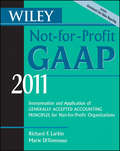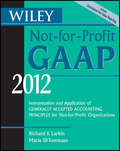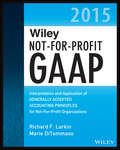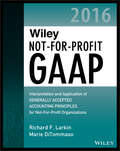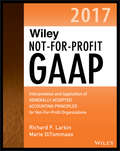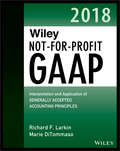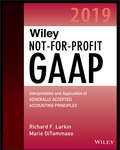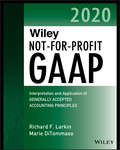- Table View
- List View
Wiley Not-for-Profit GAAP 2011: Interpretation and Application of Generally Accepted Accounting Principles
by Richard F. Larkin Marie DiTommasoThe most practical, authoritative guide to not-for-profit GAAP Wiley Not-for-Profit GAAP 2011 is a comprehensive, easy-to-use guide to the accounting and financial reporting principles used by not-for-profit organizations. Written with the needs of the financial statement preparer, user, and attestor in mind, this guide provides a complete review of the authoritative accounting literature that impacts all types of not-for-profit organizations. At the same time, Wiley Not-for-Profit GAAP 2011 features many examples and illustrations that will assist professionals in applying authoritative literature to real-life situations. Easy-to-use information that enables users to find needed information quickly Coverage of accounting principles specifically related to not-for-profit organizations, as well as accounting principles applicable to all types of organizations Specific coverage of accounting issues for different types of not-for-profit organizations A comprehensive disclosure checklist that helps financial statement preparers and attestors ensure that all disclosures required by GAAP have been considered Many examples and illustrations that make putting accounting theory into practice an easy task Destined to become the reference you keep at your side, Wiley Not-for-Profit GAAP 2011 strives to be a thorough, reliable reference that nonprofit accounting professionals will use constantly.
Wiley Not-for-Profit GAAP 2011: Interpretation and Application of Generally Accepted Accounting Principles
by Richard F. Larkin Marie DiTommasoThe most practical, authoritative guide to not-for-profit GAAP Wiley Not-for-Profit GAAP 2011 is a comprehensive, easy-to-use guide to the accounting and financial reporting principles used by not-for-profit organizations. Written with the needs of the financial statement preparer, user, and attestor in mind, this guide provides a complete review of the authoritative accounting literature that impacts all types of not-for-profit organizations. At the same time, Wiley Not-for-Profit GAAP 2011 features many examples and illustrations that will assist professionals in applying authoritative literature to real-life situations. Easy-to-use information that enables users to find needed information quickly Coverage of accounting principles specifically related to not-for-profit organizations, as well as accounting principles applicable to all types of organizations Specific coverage of accounting issues for different types of not-for-profit organizations A comprehensive disclosure checklist that helps financial statement preparers and attestors ensure that all disclosures required by GAAP have been considered Many examples and illustrations that make putting accounting theory into practice an easy task Destined to become the reference you keep at your side, Wiley Not-for-Profit GAAP 2011 strives to be a thorough, reliable reference that nonprofit accounting professionals will use constantly.
Wiley Not-for-Profit GAAP 2012: Interpretation and Application of Generally Accepted Accounting Principles
by Richard F. Larkin Marie DiTommasoThe most practical, authoritative guide to not-for-profit GAAP Wiley Not-for-Profit GAAP 2012 is a comprehensive, easy-to-use guide to the accounting and financial reporting principles used by not-for-profit organizations. Written with the needs of the financial statement preparer, user, and attestor in mind, this guide provides a complete review of the authoritative accounting literature that impacts all types of not-for-profit organizations. At the same time, Wiley Not-for-Profit GAAP 2012 features many examples and illustrations that will assist professionals in applying authoritative literature to real-life situations. Easy-to-use information that enables users to find needed information quickly Coverage of accounting principles specifically related to not-for-profit organizations, as well as accounting principles applicable to all types of organizations Specific coverage of accounting issues for different types of not-for-profit organizations A disclosure checklist that helps financial statement preparers and attestors ensure that all disclosures required by GAAP have been considered Flowcharts, diagrams, and charts, wherever possible, to help facilitate the user's understanding of the material presented Destined to become the reference you keep at your side, Wiley Not-for-Profit GAAP 2012 strives to be a thorough, reliable reference that nonprofit accounting professionals will use constantly.
Wiley Not-for-Profit GAAP 2012: Interpretation and Application of Generally Accepted Accounting Principles
by Richard F. Larkin Marie DiTommasoThe most practical, authoritative guide to not-for-profit GAAP Wiley Not-for-Profit GAAP 2012 is a comprehensive, easy-to-use guide to the accounting and financial reporting principles used by not-for-profit organizations. Written with the needs of the financial statement preparer, user, and attestor in mind, this guide provides a complete review of the authoritative accounting literature that impacts all types of not-for-profit organizations. At the same time, Wiley Not-for-Profit GAAP 2012 features many examples and illustrations that will assist professionals in applying authoritative literature to real-life situations. Easy-to-use information that enables users to find needed information quickly Coverage of accounting principles specifically related to not-for-profit organizations, as well as accounting principles applicable to all types of organizations Specific coverage of accounting issues for different types of not-for-profit organizations A disclosure checklist that helps financial statement preparers and attestors ensure that all disclosures required by GAAP have been considered Flowcharts, diagrams, and charts, wherever possible, to help facilitate the user's understanding of the material presented Destined to become the reference you keep at your side, Wiley Not-for-Profit GAAP 2012 strives to be a thorough, reliable reference that nonprofit accounting professionals will use constantly.
Wiley Not-for-Profit GAAP 2015: Interpretation and Application of Generally Accepted Accounting Principles (Wiley Regulatory Reporting)
by Richard F. Larkin Marie DiTommaso Warren RuppelDetailed, practical coverage of GAAP, tailored to not-for-profit organizations Wiley Not-for-Profit GAAP 2015 is a thorough examination of the authoritative standards for measurement, presentation, and disclosure as applied to not-for-profit organizations. Clear and concise, this user-friendly guide explains the fundamentals of GAAP in an easily-accessible format that includes flowcharts and diagrams to help facilitate the reader's understanding of the material presented, including a financial statement disclosure checklist to confirm GAAP adherence. Designed specifically for accountants in public practice and industry, this guide covers all relevant FASB and AICPA guidelines, to provide a complete reference tool for auditors who need a comprehensive understanding of GAAP for not-for-profit organizations. Due to these organizations' unique characteristics, not-for-profit accountants must adhere to specific Generally Accepted Accounting Principles. These requirements are complex and ever evolving, but Wiley Not-for-Profit GAAP 2015 brings them together in a single volume that contains the most up-to-the-minute information available. Refine basic financial statements, including Financial Position, Activities, and Cash Flow Tackle not-for-profit-specific issues like fundraising, noncash contributions, affiliations, and pledges Tailor accounting methods to the specific type of organization, with budgeting, tax reporting, and regulatory advice Discover how general accounting topics like assets, mergers, and liabilities are applied to not-for-profit organizations Preparers and auditors of not-for-profit accounts must stay up-to-date on the latest GAAP practices to best serve the organization, while complying with all disclosure, reporting, and regulatory requirements. Wiley Not-for-Profit GAAP 2015 provides extensive coverage and practical advice on the latest GAAP, tailored to the not-for-profit organization's unique needs.
Wiley Not-for-Profit GAAP 2015: Interpretation and Application of Generally Accepted Accounting Principles (Wiley Regulatory Reporting)
by Richard F. Larkin Marie DiTommaso Warren RuppelDetailed, practical coverage of GAAP, tailored to not-for-profit organizations Wiley Not-for-Profit GAAP 2015 is a thorough examination of the authoritative standards for measurement, presentation, and disclosure as applied to not-for-profit organizations. Clear and concise, this user-friendly guide explains the fundamentals of GAAP in an easily-accessible format that includes flowcharts and diagrams to help facilitate the reader's understanding of the material presented, including a financial statement disclosure checklist to confirm GAAP adherence. Designed specifically for accountants in public practice and industry, this guide covers all relevant FASB and AICPA guidelines, to provide a complete reference tool for auditors who need a comprehensive understanding of GAAP for not-for-profit organizations. Due to these organizations' unique characteristics, not-for-profit accountants must adhere to specific Generally Accepted Accounting Principles. These requirements are complex and ever evolving, but Wiley Not-for-Profit GAAP 2015 brings them together in a single volume that contains the most up-to-the-minute information available. Refine basic financial statements, including Financial Position, Activities, and Cash Flow Tackle not-for-profit-specific issues like fundraising, noncash contributions, affiliations, and pledges Tailor accounting methods to the specific type of organization, with budgeting, tax reporting, and regulatory advice Discover how general accounting topics like assets, mergers, and liabilities are applied to not-for-profit organizations Preparers and auditors of not-for-profit accounts must stay up-to-date on the latest GAAP practices to best serve the organization, while complying with all disclosure, reporting, and regulatory requirements. Wiley Not-for-Profit GAAP 2015 provides extensive coverage and practical advice on the latest GAAP, tailored to the not-for-profit organization's unique needs.
Wiley Not-for-Profit GAAP 2016: Interpretation and Application of Generally Accepted Accounting Principles (Wiley Regulatory Reporting)
by Richard F. Larkin Marie DiTommasoDetailed, practical coverage of GAAP, tailored to not-for-profit organizations Wiley Not-for-Profit GAAP 2016 is a thorough examination of the authoritative standards for measurement, presentation and disclosure as applied to not-for-profit organizations. Due to these organizations' unique characteristics, not-for-profit accountants must adhere to specific Generally Accepted Accounting Principles (GAAP). These requirements are complex and ever evolving, but this single volume brings them together, providing the most up-to-date information available. Flowcharts and diagrams are used to assist the reader's understanding of the material. Additionally, a financial statement disclosure checklist facilitates GAAP adherence. Designed specifically for accountants in public practice and industry, this guide covers requirements from all relevant organizations, including the Financial Accounting Standards Board (FASB) and Accounting Principles Board (APB). Technical and accounting research bulletins are clearly and concisely summarized, as are all statements of position important to not-for-profit organizations. Together, these resources make Wiley Not-for-Profit GAAP 2016 a complete reference tool for auditors and financial personnel in the not-for-profit sector. Refine basic financial statements, including Financial Position, Activities and Cash Flow Tackle not-for-profit-specific issues like fundraising, noncash contributions, affiliations and pledges Tailor accounting methods to the specific type of organization, with budgeting, tax reporting and regulatory advice Discover how general accounting topics like assets, mergers and liabilities are applied to not-for-profit organizations Preparers and auditors of not-for-profit accounts must stay up-to-date on the latest GAAP practices to best serve the organization, while complying with all disclosure, reporting and regulatory requirements. Wiley Not-for-Profit GAAP 2016 provides extensive coverage and practical advice on the latest GAAP, tailored to the not-for-profit organization's unique needs.
Wiley Not-for-Profit GAAP 2016: Interpretation and Application of Generally Accepted Accounting Principles (Wiley Regulatory Reporting)
by Richard F. Larkin Marie DiTommasoDetailed, practical coverage of GAAP, tailored to not-for-profit organizations Wiley Not-for-Profit GAAP 2016 is a thorough examination of the authoritative standards for measurement, presentation and disclosure as applied to not-for-profit organizations. Due to these organizations' unique characteristics, not-for-profit accountants must adhere to specific Generally Accepted Accounting Principles (GAAP). These requirements are complex and ever evolving, but this single volume brings them together, providing the most up-to-date information available. Flowcharts and diagrams are used to assist the reader's understanding of the material. Additionally, a financial statement disclosure checklist facilitates GAAP adherence. Designed specifically for accountants in public practice and industry, this guide covers requirements from all relevant organizations, including the Financial Accounting Standards Board (FASB) and Accounting Principles Board (APB). Technical and accounting research bulletins are clearly and concisely summarized, as are all statements of position important to not-for-profit organizations. Together, these resources make Wiley Not-for-Profit GAAP 2016 a complete reference tool for auditors and financial personnel in the not-for-profit sector. Refine basic financial statements, including Financial Position, Activities and Cash Flow Tackle not-for-profit-specific issues like fundraising, noncash contributions, affiliations and pledges Tailor accounting methods to the specific type of organization, with budgeting, tax reporting and regulatory advice Discover how general accounting topics like assets, mergers and liabilities are applied to not-for-profit organizations Preparers and auditors of not-for-profit accounts must stay up-to-date on the latest GAAP practices to best serve the organization, while complying with all disclosure, reporting and regulatory requirements. Wiley Not-for-Profit GAAP 2016 provides extensive coverage and practical advice on the latest GAAP, tailored to the not-for-profit organization's unique needs.
Wiley Not-for-Profit GAAP 2017: Interpretation and Application of Generally Accepted Accounting Principles (Wiley Regulatory Reporting)
by Richard F. Larkin Marie DiTommaso Warren RuppelThe essential not-for-profit GAAP reference, updated with the latest standards Wiley Not-for-Profit GAAP 2017 is the essential accounting resource for not-for-profit organizations, providing quick access to the most up-to-date standards and practical tools for implementation. Designed help you find the answers you need quickly and easily, this guide features helpful visual aids alongside detailed explanations tailored to the not-for-profit sector. Authoritative discussion covers Financial Accounting Standards Board (FASB) Accounting Standards Codification, which includes the standards originally issued in the Statements, Interpretations and Technical Bulletins; Accounting Principles Board Opinions, Accounting Research Bulletins, AICPA Statements of Position and FASB Emerging Issues Task Force statements relevant to the not-for-profit organization. The unique characteristics of the not-for-profit organization demand adherence to specific GAAP; auditors and preparers must understand these standards, stay up-to-date as they continue to evolve and know how to apply them in the course of real-world financial statement preparation. This book provides the guidance you need in a user-friendly format. Get up to date on the latest changes to GAAP affecting not-for-profit organizations Reference authoritative standards for measurement, presentation and disclosure Consult flowcharts, diagrams and charts to find answers at a glance Double-check disclosures against a checklist of GAAP requirements Accounting standards are constantly changing, and the special requirements targeting not-for-profits add an additional challenge to full compliance. Instead of wading through dozens of volumes of official pronouncements to locate relevant information, consult an all-in-one resource targeted specifically to not-for-profit GAAP — one that is updated annually to bring you the most current information available. Wiley Not-for-Profit GAAP 2017 provides clear answers and practical guidance to help you streamline GAAP implementation and ensure compliance.
Wiley Not-for-Profit GAAP 2017: Interpretation and Application of Generally Accepted Accounting Principles (Wiley Regulatory Reporting)
by Richard F. Larkin Marie DiTommaso Warren RuppelThe essential not-for-profit GAAP reference, updated with the latest standards Wiley Not-for-Profit GAAP 2017 is the essential accounting resource for not-for-profit organizations, providing quick access to the most up-to-date standards and practical tools for implementation. Designed help you find the answers you need quickly and easily, this guide features helpful visual aids alongside detailed explanations tailored to the not-for-profit sector. Authoritative discussion covers Financial Accounting Standards Board (FASB) Accounting Standards Codification, which includes the standards originally issued in the Statements, Interpretations and Technical Bulletins; Accounting Principles Board Opinions, Accounting Research Bulletins, AICPA Statements of Position and FASB Emerging Issues Task Force statements relevant to the not-for-profit organization. The unique characteristics of the not-for-profit organization demand adherence to specific GAAP; auditors and preparers must understand these standards, stay up-to-date as they continue to evolve and know how to apply them in the course of real-world financial statement preparation. This book provides the guidance you need in a user-friendly format. Get up to date on the latest changes to GAAP affecting not-for-profit organizations Reference authoritative standards for measurement, presentation and disclosure Consult flowcharts, diagrams and charts to find answers at a glance Double-check disclosures against a checklist of GAAP requirements Accounting standards are constantly changing, and the special requirements targeting not-for-profits add an additional challenge to full compliance. Instead of wading through dozens of volumes of official pronouncements to locate relevant information, consult an all-in-one resource targeted specifically to not-for-profit GAAP — one that is updated annually to bring you the most current information available. Wiley Not-for-Profit GAAP 2017 provides clear answers and practical guidance to help you streamline GAAP implementation and ensure compliance.
Wiley Not-for-Profit GAAP 2018: Interpretation and Application of Generally Accepted Accounting Principles
by Richard F. Larkin Marie DiTommasoThe essential not-for-profit GAAP reference, updated with the latest standards Wiley Not-for-Profit GAAP 2018 is the essential accounting resource for not-for-profit organizations, providing quick access to the most up-to-date standards and practical tools for implementation. Designed help you find the answers you need quickly and easily, this guide features helpful visual aids alongside detailed explanations tailored to the not-for-profit sector. Authoritative discussion covers Financial Accounting Standards Board (FASB) Accounting Standards Codification, which includes the standards originally issued in the Statements, Interpretations and Technical Bulletins; Accounting Principles Board Opinions, Accounting Research Bulletins, AICPA Statements of Position and FASB Emerging Issues Task Force statements relevant to the not-for-profit organization. The unique characteristics of the not-for-profit organization demand adherence to specific GAAP; auditors and preparers must understand these standards, stay up-to-date as they continue to evolve and know how to apply them in the course of real-world financial statement preparation. This book provides the guidance you need in a user-friendly format. Get up to date on the latest changes to GAAP affecting not-for-profit organizations Reference authoritative standards for measurement, presentation and disclosure Consult flowcharts, diagrams and charts to find answers at a glance Double-check disclosures against a checklist of GAAP requirements Accounting standards are constantly changing, and the special requirements targeting not-for-profits add an additional challenge to full compliance. Instead of wading through dozens of volumes of official pronouncements to locate relevant information, consult an all-in-one resource targeted specifically to not-for-profit GAAP — one that is updated annually to bring you the most current information available. Wiley Not-for-Profit GAAP 2018 provides clear answers and practical guidance to help you streamline GAAP implementation and ensure compliance.
Wiley Not-for-Profit GAAP 2019: Interpretation and Application of Generally Accepted Accounting Principles
by Richard F. Larkin Marie DiTommasoThe essential not-for-profit GAAP reference, updated with the latest standards Wiley Not-for-Profit GAAP 2019 is the essential accounting resource for not-for-profit organizations, providing quick access to the most up-to-date standards and practical tools for implementation. Designed help you find the answers you need quickly and easily, this guide features helpful visual aids alongside detailed explanations tailored to the not-for-profit sector. Authoritative discussion covers Financial Accounting Standards Board (FASB) Accounting Standards Codification, which includes the standards originally issued in the Statements, Interpretations and Technical Bulletins; Accounting Principles Board Opinions, Accounting Research Bulletins, AICPA Statements of Position and FASB Emerging Issues Task Force statements relevant to the not-for-profit organization. The unique characteristics of the not-for-profit organization demand adherence to specific GAAP; auditors and preparers must understand these standards, stay up-to-date as they continue to evolve and know how to apply them in the course of real-world financial statement preparation. This book provides the guidance you need in a user-friendly format. Get up to date on the latest changes to GAAP affecting not-for-profit organizations Reference authoritative standards for measurement, presentation and disclosure Consult flowcharts, diagrams and charts to find answers at a glance Double-check disclosures against a checklist of GAAP requirements Accounting standards are constantly changing, and the special requirements targeting not-for-profits add an additional challenge to full compliance. Instead of wading through dozens of volumes of official pronouncements to locate relevant information, consult an all-in-one resource targeted specifically to not-for-profit GAAP — one that is updated annually to bring you the most current information available. Wiley Not-for-Profit GAAP 2019 provides clear answers and practical guidance to help you streamline GAAP implementation and ensure compliance.
Wiley Not-for-Profit GAAP 2019: Interpretation and Application of Generally Accepted Accounting Principles
by Richard F. Larkin Marie DiTommasoThe essential not-for-profit GAAP reference, updated with the latest standards Wiley Not-for-Profit GAAP 2019 is the essential accounting resource for not-for-profit organizations, providing quick access to the most up-to-date standards and practical tools for implementation. Designed help you find the answers you need quickly and easily, this guide features helpful visual aids alongside detailed explanations tailored to the not-for-profit sector. Authoritative discussion covers Financial Accounting Standards Board (FASB) Accounting Standards Codification, which includes the standards originally issued in the Statements, Interpretations and Technical Bulletins; Accounting Principles Board Opinions, Accounting Research Bulletins, AICPA Statements of Position and FASB Emerging Issues Task Force statements relevant to the not-for-profit organization. The unique characteristics of the not-for-profit organization demand adherence to specific GAAP; auditors and preparers must understand these standards, stay up-to-date as they continue to evolve and know how to apply them in the course of real-world financial statement preparation. This book provides the guidance you need in a user-friendly format. Get up to date on the latest changes to GAAP affecting not-for-profit organizations Reference authoritative standards for measurement, presentation and disclosure Consult flowcharts, diagrams and charts to find answers at a glance Double-check disclosures against a checklist of GAAP requirements Accounting standards are constantly changing, and the special requirements targeting not-for-profits add an additional challenge to full compliance. Instead of wading through dozens of volumes of official pronouncements to locate relevant information, consult an all-in-one resource targeted specifically to not-for-profit GAAP — one that is updated annually to bring you the most current information available. Wiley Not-for-Profit GAAP 2019 provides clear answers and practical guidance to help you streamline GAAP implementation and ensure compliance.
Wiley Not-for-Profit GAAP 2020: Interpretation and Application of Generally Accepted Accounting Principles (Wiley Regulatory Reporting)
by Warren Ruppel Richard F. Larkin Marie DiTommasoEnsure that your not-for-profit accounting is airtight for 2020 Not-for profit organizations have unique characteristics, so they must adhere to a specific set of generally accepted accounting principles (GAAP). Wiley Not-For-Profit GAAP 2020 provides practical guidance on how to identify and apply the relevant standards. This guide is indispensable for professionals responsible for preparing and auditing not-for-profit accounts. You will learn how to interpret the relevant accounting principles and how to apply them, all while minimizing unnecessary effort and eliminating potentially costly errors. This comprehensive yet concise text thoroughly examines the latest standards for measurement, presentation, and disclosure related to not-for-profits. It covers the Financial Accounting Standards Board (FASB) Accounting Standards Codification, all relevant Accounting Standards Updates, and other guidance that applies to not-for-profit organizations, particularly that of the American Institute of Certified Public Accountants (AICPA). With this unrivalled reference tool, your not-for-profit GAAP questions are answered. Easily understand the latest not-for-profit GAAP with visual aids, including flowcharts, diagrams, and illustrations Navigate complex requirements and ensure completeness of GAAP disclosures Stay current with all not-for-profit accounting pronouncements, including FASB, AICPA, and more Enjoy practical, user-friendly guidance on applying the relevant accounting standards in your not-for-profit organization With Wiley Not-For-Profit GAAP 2020, you can be assured you have the most current, comprehensive accounting information that applies to nonprofit organizations. Stay in compliance and ensure timely, accurate reporting with this authoritative volume.
Wiley Not-for-Profit GAAP 2020: Interpretation and Application of Generally Accepted Accounting Principles (Wiley Regulatory Reporting)
by Warren Ruppel Richard F. Larkin Marie DiTommasoEnsure that your not-for-profit accounting is airtight for 2020 Not-for profit organizations have unique characteristics, so they must adhere to a specific set of generally accepted accounting principles (GAAP). Wiley Not-For-Profit GAAP 2020 provides practical guidance on how to identify and apply the relevant standards. This guide is indispensable for professionals responsible for preparing and auditing not-for-profit accounts. You will learn how to interpret the relevant accounting principles and how to apply them, all while minimizing unnecessary effort and eliminating potentially costly errors. This comprehensive yet concise text thoroughly examines the latest standards for measurement, presentation, and disclosure related to not-for-profits. It covers the Financial Accounting Standards Board (FASB) Accounting Standards Codification, all relevant Accounting Standards Updates, and other guidance that applies to not-for-profit organizations, particularly that of the American Institute of Certified Public Accountants (AICPA). With this unrivalled reference tool, your not-for-profit GAAP questions are answered. Easily understand the latest not-for-profit GAAP with visual aids, including flowcharts, diagrams, and illustrations Navigate complex requirements and ensure completeness of GAAP disclosures Stay current with all not-for-profit accounting pronouncements, including FASB, AICPA, and more Enjoy practical, user-friendly guidance on applying the relevant accounting standards in your not-for-profit organization With Wiley Not-For-Profit GAAP 2020, you can be assured you have the most current, comprehensive accounting information that applies to nonprofit organizations. Stay in compliance and ensure timely, accurate reporting with this authoritative volume.
Wiley Practitioner's Guide to GAAP 2022: Interpretation and Application of Generally Accepted Accounting Principles (Wiley Regulatory Reporting)
by Joanne M. FloodThe most comprehensive guide to US GAAP—thoroughly updated to reflect the latest pronouncements US GAAP is constantly being updated, requiring its users to be armed with expert interpretation and explanation of the relevant principles. Wiley GAAP 2022 provides the most complete coverage of all Financial Accounting Standards Board (FASB) Topics—including the latest updates. Each chapter includes discussion of perspectives and issues, sources of GAAP, practice-oriented examples, and accurate definitions of terms, concepts, and rules. Every FASB Topic is fully explained in a clear, reader-friendly way with dynamic graphic to aid in understanding complex topics. Extensively updated to reflect all current US GAAP changes, this indispensable book: Reviews the latest changes to accounting principles, including inventory, financial instruments, leases, debt, and goodwill Offers expert guidance on issues surrounding specific pronouncements Includes comprehensive cross-references and topic-specific appendices Explains how the standards apply to common real-world scenarios Clarifies implementation through numerous illustrations and practical examples Accurate and up-to-date GAAP implementation is crucial for eliminating the risk of noncompliance. Wiley GAAP 2022 is your one-stop resource for staying up-to-date with constantly-changing guidelines—providing the insight and guidance accounting professionals need.
Wiley Practitioner's Guide to GAAP 2022: Interpretation and Application of Generally Accepted Accounting Principles (Wiley Regulatory Reporting)
by Joanne M. FloodThe most comprehensive guide to US GAAP—thoroughly updated to reflect the latest pronouncements US GAAP is constantly being updated, requiring its users to be armed with expert interpretation and explanation of the relevant principles. Wiley GAAP 2022 provides the most complete coverage of all Financial Accounting Standards Board (FASB) Topics—including the latest updates. Each chapter includes discussion of perspectives and issues, sources of GAAP, practice-oriented examples, and accurate definitions of terms, concepts, and rules. Every FASB Topic is fully explained in a clear, reader-friendly way with dynamic graphic to aid in understanding complex topics. Extensively updated to reflect all current US GAAP changes, this indispensable book: Reviews the latest changes to accounting principles, including inventory, financial instruments, leases, debt, and goodwill Offers expert guidance on issues surrounding specific pronouncements Includes comprehensive cross-references and topic-specific appendices Explains how the standards apply to common real-world scenarios Clarifies implementation through numerous illustrations and practical examples Accurate and up-to-date GAAP implementation is crucial for eliminating the risk of noncompliance. Wiley GAAP 2022 is your one-stop resource for staying up-to-date with constantly-changing guidelines—providing the insight and guidance accounting professionals need.
Wiley Practitioner's Guide to GAAS 2010: Covering all SASs, SSAEs, SSARSs, and Interpretations
by Steven M. BraggYour clearest, easiest-to-use guide to understanding GAAS 2010 on the market-fully updated! This latest resource to understanding GAAS addresses the toughest part of your job-identifying, interpreting, and applying the many audit, attest, review, and compilation standards relevant to a particular engagement. Wiley Practitioner's Guide to GAAS 2010 offers you A brief identification of each SAS, SSAE, and SSARS, with its effective date and tips on when to apply it A convenient and comprehensive glossary of official definitions, which are usually scattered throughout a standard Behind-the-scenes explanations of the reasons for each pronouncement and brief explanations of the basic ideas of the section Concise listing and descriptions of each standard's specific mandates Easy-to-read capsule summary of interpretations, plus selected AICPA practice alerts and advisories Helpful techniques for remaining compliant with each standard Examples and illustrations for testing internal controls The only GAAS reference organized according to your actual use of the Statements on Auditing Standards (SASs), Wiley Practitioner's Guide to GAAS 2010 presents each statement individually, explaining how the standards are related and offering you guidance on the entire engagement process in the form of practice notes, checklists, questionnaires, and real-world examples that illustrate how the fundamental requirements of each section are applied.
Wiley Practitioner's Guide to GAAS 2012: Covering all SASs, SSAEs, SSARSs, and Interpretations
by Steven M. BraggThe clearest, easiest-to-use guide to understanding GAAS 2012 on the market—fully updated This latest resource to understanding GAAS addresses the toughest part of the job—identifying, interpreting, and applying the many audit, attest, review, and compilation standards relevant to a particular engagement. The only GAAS reference organized according to practitioners' actual use of the Statements on Auditing Standards (SASs), inside you'll find examples and illustrations for testing internal controls, techniques for remaining compliant with each standard, and explanations of the reasons for each pronouncement. A brief identification of each SAS, SSAE, and SSARS, with its effective date and tips on when to apply it A convenient and comprehensive glossary of official definitions, which are usually scattered throughout a standard Behind-the-scenes explanations of the reasons for each pronouncement and brief explanations of the basic ideas of the section Concise listing and descriptions of each standard's specific mandate Easy-to-read capsule summary of interpretations, plus selected AICPA practice alerts and advisories Helpful techniques for remaining compliant with each standard Examples and illustrations for testing internal controls Wiley Practitioner's Guide to GAAS 2012 presents each statement individually, explaining how the standards are related and offering guidance on the entire engagement process in the form of practice notes, checklists, questionnaires, and real-world examples that illustrate how the fundamental requirements of each section are applied.
Wiley Practitioner's Guide to GAAS 2012: Covering all SASs, SSAEs, SSARSs, and Interpretations
by Steven M. BraggThe clearest, easiest-to-use guide to understanding GAAS 2012 on the market—fully updated This latest resource to understanding GAAS addresses the toughest part of the job—identifying, interpreting, and applying the many audit, attest, review, and compilation standards relevant to a particular engagement. The only GAAS reference organized according to practitioners' actual use of the Statements on Auditing Standards (SASs), inside you'll find examples and illustrations for testing internal controls, techniques for remaining compliant with each standard, and explanations of the reasons for each pronouncement. A brief identification of each SAS, SSAE, and SSARS, with its effective date and tips on when to apply it A convenient and comprehensive glossary of official definitions, which are usually scattered throughout a standard Behind-the-scenes explanations of the reasons for each pronouncement and brief explanations of the basic ideas of the section Concise listing and descriptions of each standard's specific mandate Easy-to-read capsule summary of interpretations, plus selected AICPA practice alerts and advisories Helpful techniques for remaining compliant with each standard Examples and illustrations for testing internal controls Wiley Practitioner's Guide to GAAS 2012 presents each statement individually, explaining how the standards are related and offering guidance on the entire engagement process in the form of practice notes, checklists, questionnaires, and real-world examples that illustrate how the fundamental requirements of each section are applied.
Wiley Registered Tax Return Preparer Exam Review 2012
by The Tax Institute at H&R BlockThe most effective system available to prepare for the new Tax Return Preparer Competency Exam In recent years, the role of third party assistance in tax return preparation within the United States has become more significant. To acknowledge this trend, the IRS is strengthening partnerships with tax practitioners, tax return preparers, and other third parties in order to ensure effective tax administration that adheres to professional standards and follows the law. Beginning in 2011, tax return preparers are required to pass a competency test to officially become registered tax return preparers. The Wiley Registered Tax Return Preparer Exam Review Book 2012 has been designed with this in mind and is the perfect guide to help you pass this comprehensive test. The course, complete with extensive exercises and a final exam review, will provide you with a solid foundation on the subject of taxes, and the preparation of an accurate and complete income tax return. Along the way, it covers specific tax issues you need to be familiar with, including tax theory and law; conducting a thorough client interview; and offering tax advice and explanations to clients. Helps you zero in on areas that need work, organize your study program, and concentrate your efforts Provides paid tax return preparers who are not enrolled agents, attorneys, or Certified Professional Accountants (CPAs) with the individual taxation information they need to pass this competency test Covers the major parts of the exam and how to approach each one Informative and insightful, the Wiley Registered Tax Return Preparer Exam Review Book 2012 will put you in the best position possible to pass this important exam.
Wiley Registered Tax Return Preparer Exam Review 2012
by The Tax Institute at H&R BlockThe most effective system available to prepare for the new Tax Return Preparer Competency Exam In recent years, the role of third party assistance in tax return preparation within the United States has become more significant. To acknowledge this trend, the IRS is strengthening partnerships with tax practitioners, tax return preparers, and other third parties in order to ensure effective tax administration that adheres to professional standards and follows the law. Beginning in 2011, tax return preparers are required to pass a competency test to officially become registered tax return preparers. The Wiley Registered Tax Return Preparer Exam Review Book 2012 has been designed with this in mind and is the perfect guide to help you pass this comprehensive test. The course, complete with extensive exercises and a final exam review, will provide you with a solid foundation on the subject of taxes, and the preparation of an accurate and complete income tax return. Along the way, it covers specific tax issues you need to be familiar with, including tax theory and law; conducting a thorough client interview; and offering tax advice and explanations to clients. Helps you zero in on areas that need work, organize your study program, and concentrate your efforts Provides paid tax return preparers who are not enrolled agents, attorneys, or Certified Professional Accountants (CPAs) with the individual taxation information they need to pass this competency test Covers the major parts of the exam and how to approach each one Informative and insightful, the Wiley Registered Tax Return Preparer Exam Review Book 2012 will put you in the best position possible to pass this important exam.
Wiley-Schnellkurs Hausarbeiten und Seminararbeiten
by Daniela WeberMit dem Schreiben von Hausarbeiten kann man viel Zeit verbringen, muss man aber nicht unbedingt. Ein systematisches Vorgehen hilft hier ungemein viel Zeit zu sparen. Daniela Weber erklärt Ihnen in diesem Buch auf den Punkt und kompetent, wie Sie die Arbeit richtig gliedern, effektiv mit Quellen arbeiten, den Text verfassen und die Arbeit am Ende noch formatieren. So hilft Sie Ihnen, sich auf die wesentlichen Punkte der Arbeit zu konzentrieren und sich nicht lange mit Formalien aufzuhalten.
Wiley-Schnellkurs Logistik (Wiley Schnellkurs)
by Michael HuthLogistik, der Begriff wird immer wieder gerne genutzt, aber was ist Logistik eigentlich? Dies und vieles mehr erklärt Ihnen Michael Huth in diesem Buch. Er grenzt den Begriff von anderen ab, geht auf Logistikziele und -strategien ein und erläutert Transportlogistik und Lagerhaltung. Er führt Sie in Konzepte der Materialbeschaffung und -bereitstellung ein und gibt Ihnen einen Einblick in Distributionssysteme und Outsourcing-Entscheidungen in der Logistik. Übungsaufgaben mit Lösungen helfen Ihnen, den Stoff zu wiederholen und sich selbst zu testen. So ist dieses Buch das richtige für Sie, wenn Sie sich am Anfang oder Ende des Semesters einen schnellen Überblick über die Logistik verschaffen wollen.
Wiley Tax Preparer: A Guide to Form 1040
by The Tax Institute at H&R BlockWhether you’re already a tax preparer or you’re looking to become one, you need a firm grasp of the tax concepts on which individual taxation is based. We created the Wiley Tax Preparer as a refresher for the experienced tax preparer, and as a readable guide for the less-experienced tax preparer. This timely guide is an essential tax resource providing you with useful information on tax principles and filing requirements that a preparer must know to complete a 1040 series return and associated schedules. You’ll refer to it time and again, for information about: Practices and Procedures Penalties to be assessed by the IRS against a preparer for disregard of the rules and regulations Furnishing a copy of a return to a taxpayer Safeguarding taxpayer information Treatment of Income and Assets Taxability of wages, salaries, tips, and other earnings Reporting requirements of Social Security benefits Determination of basis of assets Deductions and Credits Medical and dental expenses Types of interest and tax payments Child and dependent care credit Other Taxes Alternative Minimum Tax Self-Employment Tax Preliminary Work and Collection of Taxpayer Data Collecting a taxpayer’s filing information and determining their status Determine filing requirements, including extensions and amended returns Personal exemptions and dependents Completion of the Filing Process Check return for completeness and accuracy Tax withholding, payment and refund options, and estimated tax payments Explaining and reviewing the tax return Ethics and Circular 230 Preparer’s due diligence for accuracy of representations made to clients and the IRS Sanctions that may be imposed under Circular 230 Rules governing authority to practice before the IRS If you’re looking for a practical guide to the principles behind Form 1040, look no further. The Wiley Tax Preparer is the most accessible guide to understanding how complex tax laws affect individual taxpayers.
